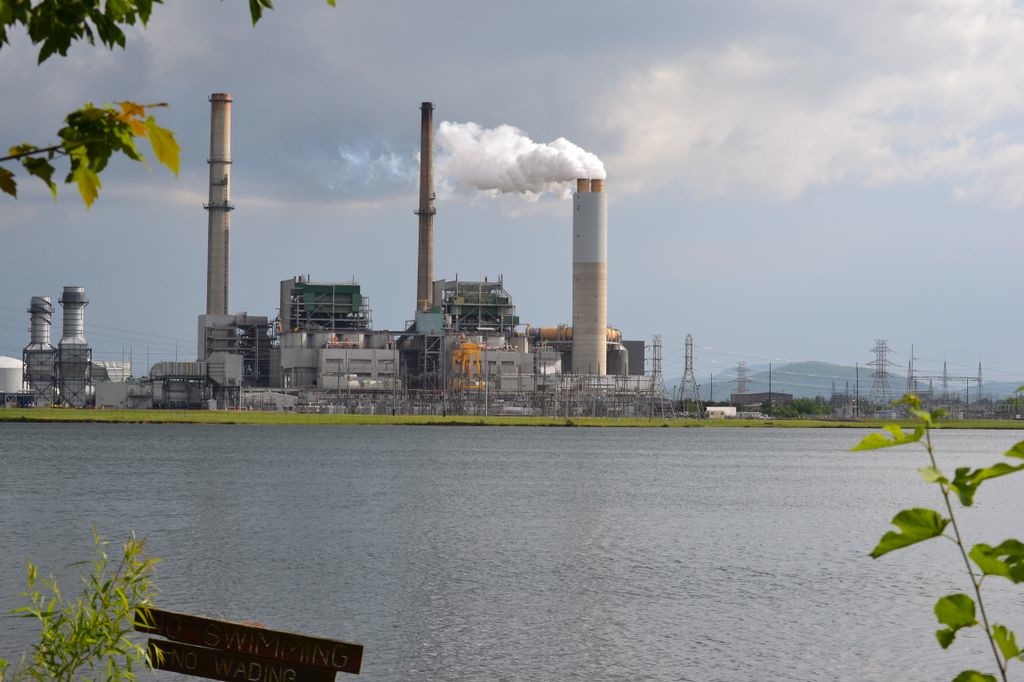


The coal-fired Asheville power plant is causing dangerous air pollution. It’s time for locals to push to rein Duke Energy in and protect our air.
Above: the Asheville power plant. Photo from the Beyond Coal campaign.
Every three to four days, communities downwind of Duke Energy’s Lake Julian facility— including parts of South Asheville, Fairview, and Leicester and some trails in the Bent Creek Forest—are in the path of dangerous air pollution from Duke’s coal-fired power plant. That’s every three to four days that folks living in this path are exposed to toxins that can trigger asthma attacks and worsen respiratory ailments. Though I have been working with Asheville Beyond Coal for two years now, this new information about the air pollution at this plant has reignited for me the urgency of this campaign.
When I was younger, I suffered from a form of bronchoconstriction that caused asthma attacks when I ran too hard. It sometimes kept me from playing with other kids and it took many years after my symptoms had subsided to be fully comfortable with exercising. Though my asthma had predictable triggers, many others are not as lucky. If you have ever had an asthma attack, you never forget what it feels like. Not knowing whether or not you will take your next breath is a terrifying experience, especially for a child.
Back in 2005 and 2006 as a result of the Clean Smokestacks Act, Duke installed scrubbers at the Lake Julian plant to protect communities from these negative health impacts. When first installed, those safeguards were run at acceptable levels to protect public health. Now, a new report shows that the plant has been emitting harmful levels of sulfur dioxide pollution (SO2) for the past several years, in amounts considered unsafe by the Environmental Protection Agency. The report, based on an air modeling study by Air Resource Specialists, shows that concentrations of SO2 in the air near people’s homes downwind of the Asheville plant are up to 3.5 times higher than what the EPA has determined to be safe. The report also shows that the plant’s pollution has exceeded these minimum public health standards about one out of every three to four days since 2010.
The obvious question here is: why? Why have these levels of SO2 increased even with the presence of up to date pollution controls on this plant? A separate analysis of operations at Duke’s Asheville plant gives us the most likely cause: Duke Energy apparently has not been running its pollution protection technology fully and, at the same time, has switched to cheaper, dirtier, higher-sulfur coal. The second conclusion is that the most likely reason Duke officials made these changes is to reduce the cost of running this plant, which is one of the utility’s most expensive to operate.
What this suggests is that Duke Energy is making a decision to cut corners on protecting our communities in an effort to save on operation costs at the Asheville coal plant. To me, this is unacceptable. If you have children, or grandparents, or others in your lives that suffer from breathing problems perhaps this resonates with you. Even if asthma has not touched your life we can all relate to wanting to protect the people we love, and can identify with the fear of not being able to help.
The Western North Carolina Regional Air Quality Agency is now working on its permit renewal process for the Asheville plant. We had hoped that the Agency would take this opportunity to require Duke to reduce its SO2 pollution enough to eliminate the threats to public health that this pollution now poses and ensure that the federal minimum air quality standard for SO2 is not exceeded.
Unfortunately the draft permit– as written– will not protect our community from air pollution released from Duke Energy’s Asheville coal plant. A coal plant without any air pollution controls (or “scrubbers”) could easily meet the limit set in this permit for toxic sulfur pollution. As it now stands, the proposed emission limit for this plant is 80 times what it would need to be to ensure the safety of communities living downwind of the plant.
Communities living downwind of the plant can’t decide not to breathe in this air pollution, only Duke Energy can make that decision to protect them. I hope sincerely that the Western North Carolina Air Quality Agency will take this opportunity to hold Duke accountable to their customers, and require a numeric limit in this new permit that will ensure their safety. I have great hope that the air quality board, who will approve or deny this permit, will take care in considering all the aspects of this issue and do right by our communities in Western North Carolina.
Nearly 20,000 children and adults suffer from asthma in Buncombe County. Lower sulfur pollution means fewer trips to the hospital, fewer asthma attacks and fewer employee absences– all of which will save the region significantly in health care and missed work costs.
When Duke starts running its pollution controls more responsibly, those most at risk, and families throughout the Asheville community, can all breathe a little easier.
—
Emma Greenbaum is a local organizer with the Asheville branch of the Sierra Club’s Beyond Coal campaign.
Those interested can tell the WNC Air Quality Board to protect families and communities from dangerous air pollution; and attend the public hearing 6 p.m. on Wednesday, April 29 at the Erwin High School auditorium (60 Lees Creek Road) in Asheville.
The Asheville Blade is entirely funded by its readers. If you like our work, donate directly to us on Patreon. Questions? Comments? Email us.